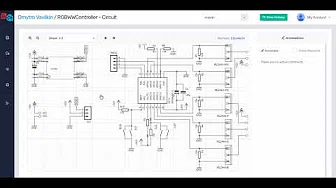Files
Scanning the repository...
readme-isolation-milling.mdNOTE: This file is deprecated, captures info from when trying to do isolation routing of traces instead of chem etching.
TODO
- [] Infill should not retrace. Do bi-di laser cutting.
- [] G2 format is wrong. Getting rejected by LaserGRBL as an invalid code.
- Proper G2: From wherever you are, you will start. Specify the XY end point withing the G2 command. I&J represent the center delta from the start point to the end of the arc.
Another project: https://sourceforge.net/p/pygerber2gcode/code/ci/master/tree/
PCB Milling
KiCAD
KiCAD Gerber export: disable the "Use extended X2 format" option.
PCB2GCODE
- This tool worked great for generating G-code.
- Much easier to use than FlatCAM.
- Man page in file
pcb2gcode.pdf.
- Example config file:
millproject - Generate code by running
pcb2gcodein the same directory withmillproject. - Use a short list of drill sizes, or it will use exact drill size for each part. That can lead to a lot of tooling changes.
- You can get some parameter by editing and running
pcb_calcs.py.- The copper layer is very thin. Got nice isolation with a margin of 0.5, could probably go lower.
- This calcs the Z depth for drilling and edge cuts to cut into the tape. It can be a bit tricky if you don't apply the height map. Not clear if you can apply the height map to multiple files.
- Bridges shouldn't be necessary if you don't cut too fast on the edge cuts.
- Example call: https://gist.github.com/bullestock/87ed51aaadaae8b8d2f085756652eb04
Mounting PCB
It is very important to get the board as flat as possible. The painters tape glued together does seem to work well if: * Mounted to the aluminum plate, not the MDF spoilboard. * Clean the aluminum with isopropal alcolhol ahead of time so tape adheres well. * While glue is drying, put a large weight on the PCB. A 5 lb sledge hammer worked well.
Tooling
The 60 degree triangular V-cut bits worked very well. Robust bit, and isolated nicely. * Inventree * Amazon
Autoleveling
- Use CNCjs autolevel module: https://github.com/kreso-t/cncjs-kt-ext
- This is loaded on the Shop Server, in the CNCjs VM.
- It's in directory
~/tmp/cncjs-kt-ext/ - It must be restarted every time the USB connection is made.
>> node . --port /dev/ttyUSB0
- Create a macro or run from the command line:
(#autolevel D7.5 H1.0 F20)F- Z-probe speed, don't go lower than 20 (mm/sec).D- Grid spacing. Defaults to 10 (mm).
Soldermask & Silkscreen
Intended process is to apply two layers of soldermask/ink to the PCB, then use my UV laser to ablate the areas that I don't want filled in. Overall technique from: https://www.youtube.com/watch?v=NuJlgw7E7vg.
Soldermask goes down nicely with: * Cover with plastic film (overhead film works well). Need rigitity. Plastic wrap is too soft. * Use a squeegee to spread the ink. I used Silicone squeegee from Amazon. * Cure with UV light. I use a resin printer cure station for 3 min with board leaning against lamp.
Essentially: 1. Lay down & cure the base soldermask (color of choice) 2. Ablate soldermask in areas where you want silkscreen. 3. Apply white ink/soldermask & cure 4. Ablate solder pads: 80% power, 200 mm/sec
Software Tooling
While FlatCAM is a very impressive piece of Python GUI software, it's cumbersome to have to do a lot of manual stuff. Per above, PCB2GCODE does a great job with the isolation routing, edge routing and drilling G-code file generation. Once you've properly parameterized your system, it's a two second opeation to go from Gerber to G-Code. Looking to add in the next steps in that tooling for laser ablation paths.
We need to go from Gerber to G-Code. Gerbonara can read Gerber files and provide graphics primitives which can be converted to G-Code by a custom Python module gbr2grbl.py. This is able to draw and fill rectangles and circles, which meets the most basic of soldermask needs.
With a "dumb" implementaiton, just generating G-code geometry, * With 0.1mm infill step size, CAMotics estimates: * Job time: 1m 21s * Total distance: 1378.1 mm. * No infill * Job time: 15s * Total distance: 239.2 mm.
With 2D position scheduling optimization * With 0.1mm infill step size, CAMotics estimates: * Job time: 1m 18s (3.7% savings) * Total distance: 778.0mm (43.5% savings) * With no infill, CAMotics estimates: * Job time: 14.9s (0.7% savings) * Total distance: 222.1mm (7.1% savings)
With Traveling Salesman optimization (greedy tsp): * With no infill, CAMotics estimates: * Job time: 14.93s (0.7% savings) * Total distance: 227.4mm (7.1% savings)
To do:
- Looks like need to flip bottom side image.
- Verify home position is correct.
- Add in laser G-code parameters as TOML config file.
- Add generation of other g-code files handled by
pcb2gcode(drill, edge route, isolation route). - Parameterize
pcb2gcodeto use the same TOML config file. - Use
.gbrjobdata forpcb2gcodeconfig. Stackup has PCB and Cu thicknesses. - Make sure I have the stackup config correct in the KiCAD PCB file.
Overall Process
Note: For all operations, keep grbl software running and maintain XY home position.
- Mount bare PCB to a flat but sacrificial material which is clamped to the mill bed. PCB mounting via glued tape attached to both surfaces. Doublesided tape will work well also.
- If the PCB is double sided, drill corner holes that can be fitted with dowell pins for locating.
- Autolevel board
- Isolation route PCB back side. Start with back side to minimize flips (assuming silksceen is front side only).
- If double sided: clean PCB apply and cure back side soldermask, flip board, repeat steps 3 & 4 for front side.
- Clean PCB, apply & cure soldermask.
- Mount laser.
- Ablate silkscreen image.
- Apply & cure silkscreen ink
- Ablate soldermask for solder pads
- Remount spindle
- Drill
- Edge route
- Tin exposed pads.








